The day after the excursion to the Samaria Gorge my plan was to go to yet another excursion to Elafonisi Beach by an islet of the same name which I had already paid for at the agency. However, they contacted me meanwhile and said that the excursion was cancelled owing to the bad weather. The weather was bad indeed, it rained and there was a very strong wind, so I had no objections about the cancelled trip.
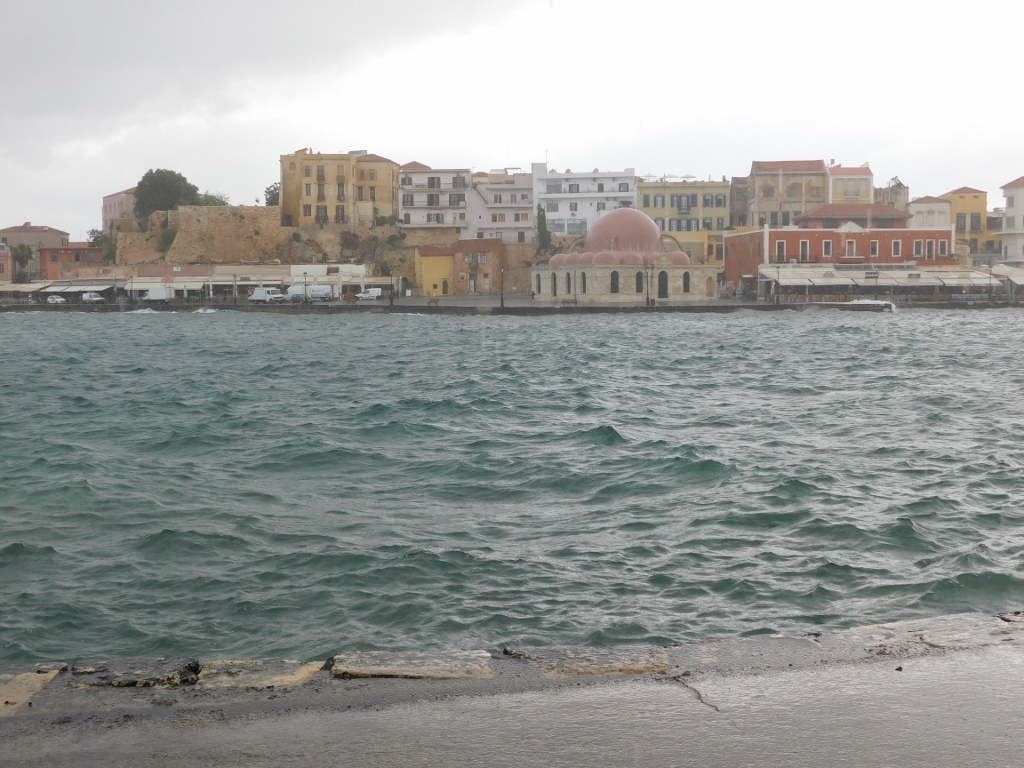 Old Venetian Port of Chania
Old Venetian Port of Chania
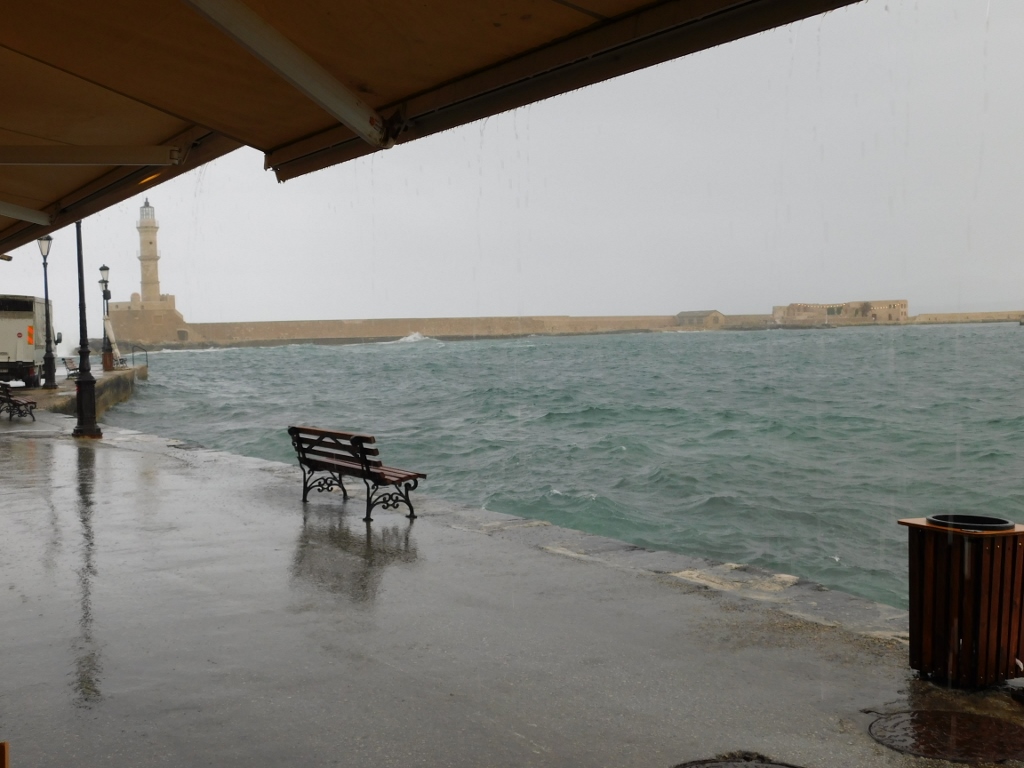 Old Venetian Port of Chania
Old Venetian Port of Chania
Still, I was not willing to spend the whole day in Chania in weather like this and so I suddenly decided to do something I usually don’t do when travelling and that was to – rent a car.
I went to the same agency, they returned my money from the cancelled excursion and then we agreed about a small car for a day. Soon I transferred by that car to the east part of Chania called Chalepa. The new and modern Archaeological Museum of Chania is located there. The museum was opened literally a month before my visit to Crete. Earlier, the museum was located in the very centre of Chania, as I’ve already mentioned, but that site was closed back in 2020.
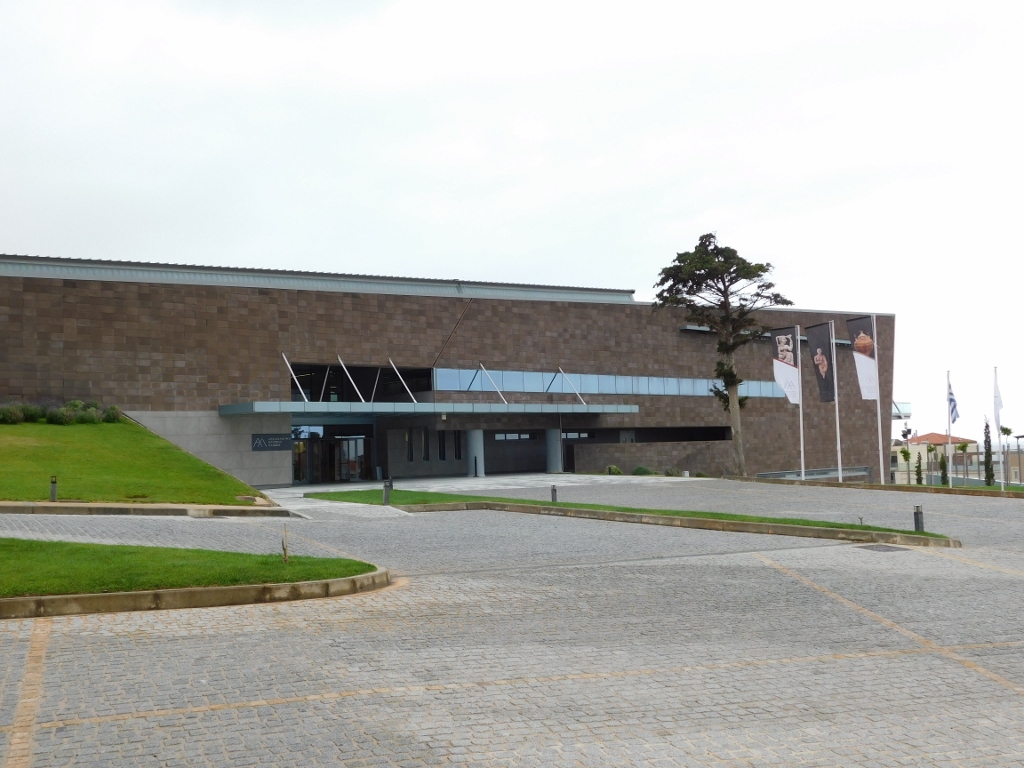 Archaeological Museum of Chania
Archaeological Museum of Chania
The museum is not particularly big, but it offers lovely exhibits and deals primarily with the artefacts found on the territory of Chania and generally west and south Crete. As for the timeframe, the exhibits come from the period of the Minoan civilisation, as well from later periods when these areas were ruled by ancient Romans.
I will show only a few things here from the museum that I found particularly interesting. For instance, pitchers from the XIII century BCE, found during the archaeological exploration of Minoan Kydonia. They are absolutely stunning and were made more than 3000 years ago!
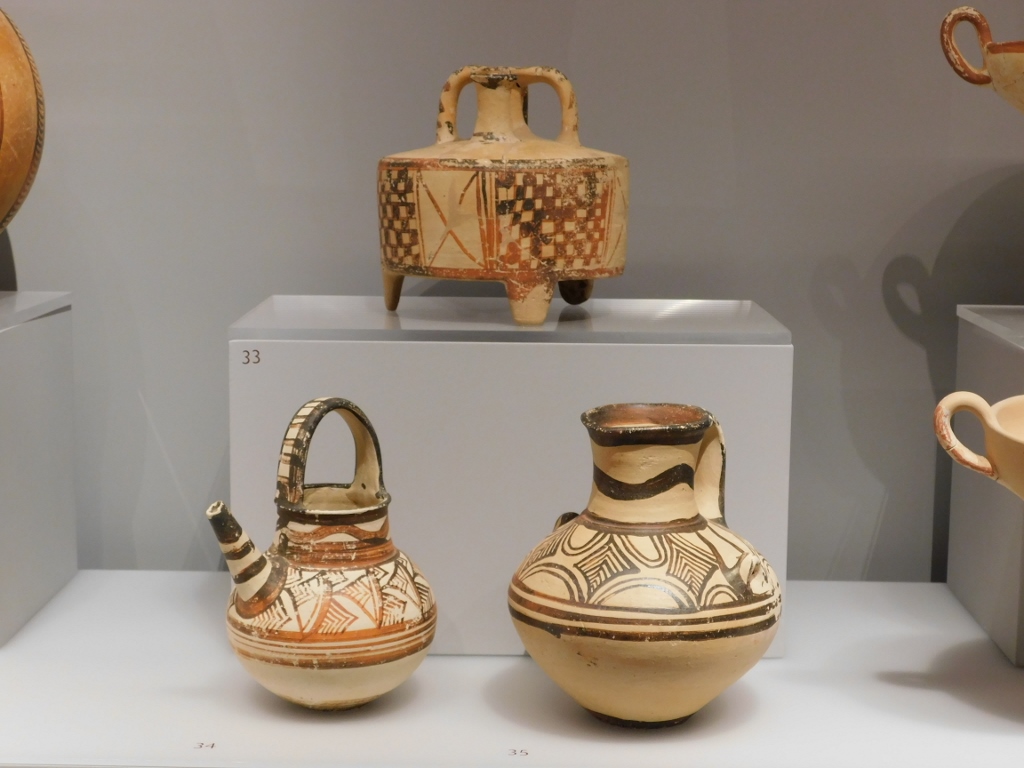 Archaeological Museum of Chania, a detail
Archaeological Museum of Chania, a detail
There are also some interesting reconstructions arranged within the museum. For instance, a reconstruction of a kitchen from 1450 BCE which, as a part of a two-storey building, got destroyed in a fire. The building was a part of the Minoan palatial centre Kydonia built on Kastelli Hill in the present-day Chania. The organic residue analysis has shown that the Minoans ate cereals and they combined vegetables, including legumes, with meat. They dried figs and among other things they drank wine mixed with honey.
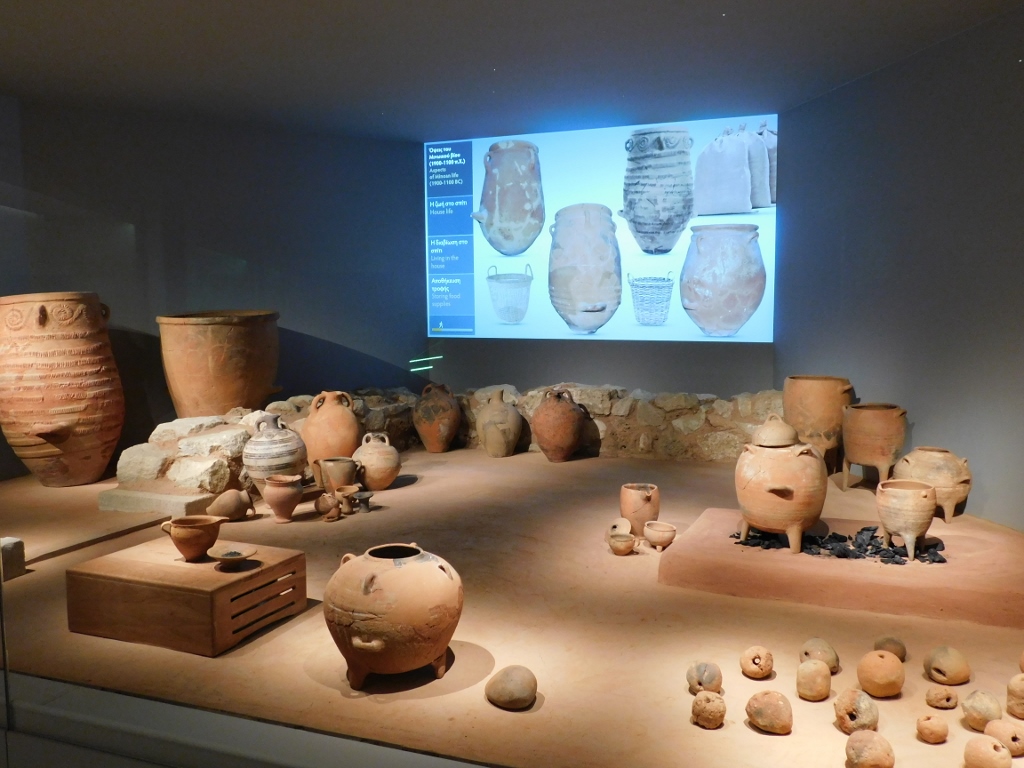 Archaeological Museum of Chania, reconstructed kitchen
Archaeological Museum of Chania, reconstructed kitchen
There is also a reconstructed tomb from the end of the XIV century BCE. Three men and two children were buried in the tomb and they were accompanied by vessels made of clay and bronze, as well as by jewellery, weapons, etc.
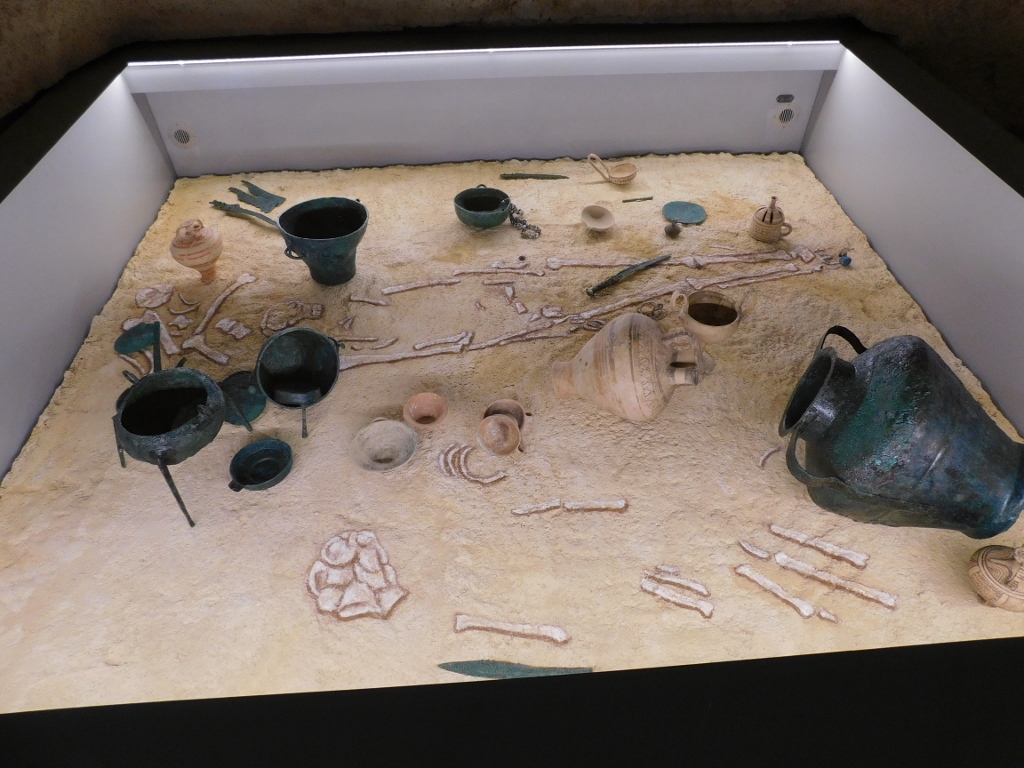 Archaeological Museum of Chania, reconstructed chamber tomb
Archaeological Museum of Chania, reconstructed chamber tomb
One of the most important finds from Kydonia is tiny by its size. This is a clay seal, “Master Impression,” with beautifully engraved details. My photo is somewhat blurred, but you can still discern a palace complex with several floors built on the top of a hill, above a port on a rocky shore – which absolutely reflects the situation in Kydonia on Kastelli hill where the seal was found in the first place.
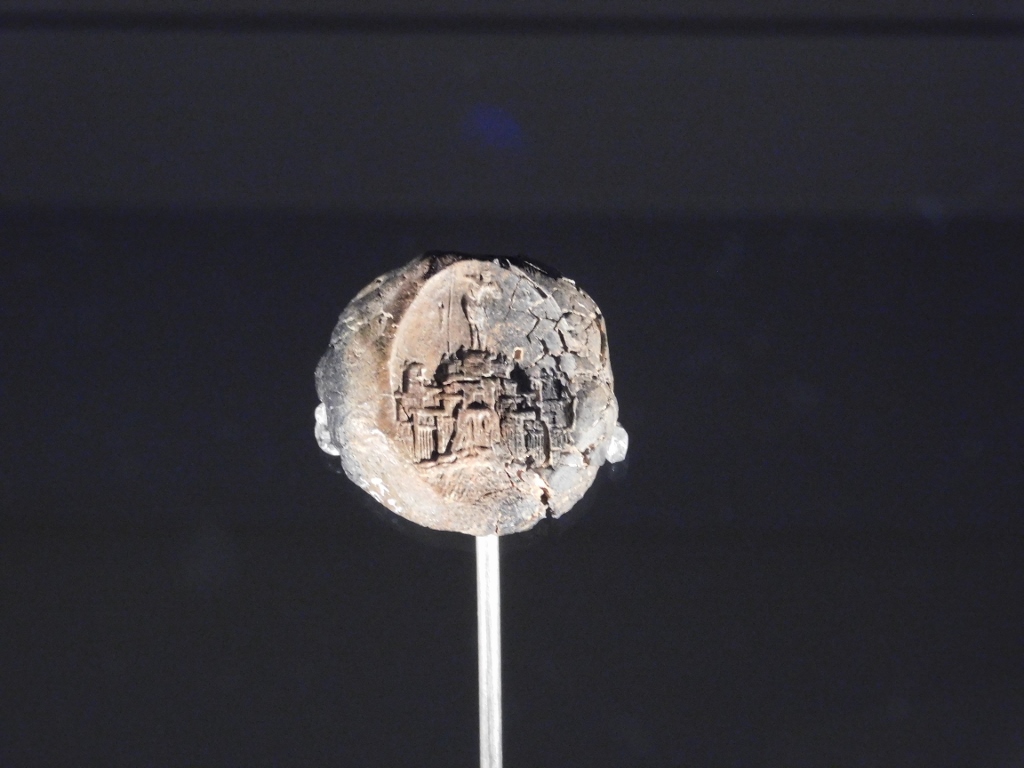 Archaeological Museum of Chania, the “Master Impression” seal
Archaeological Museum of Chania, the “Master Impression” seal
When you look a little more closely, you can also notice that the tops of the roofs are decorated by the “Horns of Consecration,” while on the top of the highest building stands proudly and straight a young man who holds a spear or a club in his hand. He is presumed to be the god-ruler and the master of the palatial complex.
But, one of the loveliest exhibits at the museum is – a toy. A toy from 800-700 BCE! This is an ox figurine, but there are also wheels and the museum has attached a rope in order to illustrate better how the toy was used. Vroom-vroom...
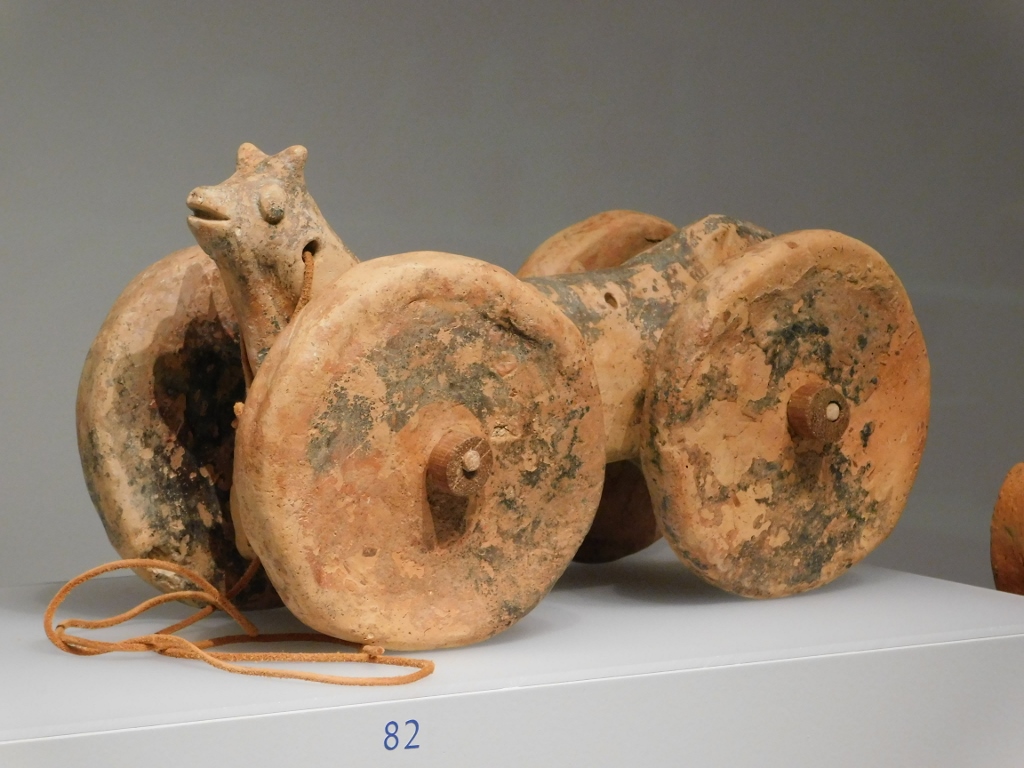 Archaeological Museum of Chania, ox figurine toy
Archaeological Museum of Chania, ox figurine toy
The toy is a part of the exhibit covering the period after the end of the Minoan civilisation, but the museum also holds exhibits from the Common Era, such as a Group of Artemis and Apollo from the II century CE. Apollo is made of marble and his twin sister, Artemis, is made of bronze.
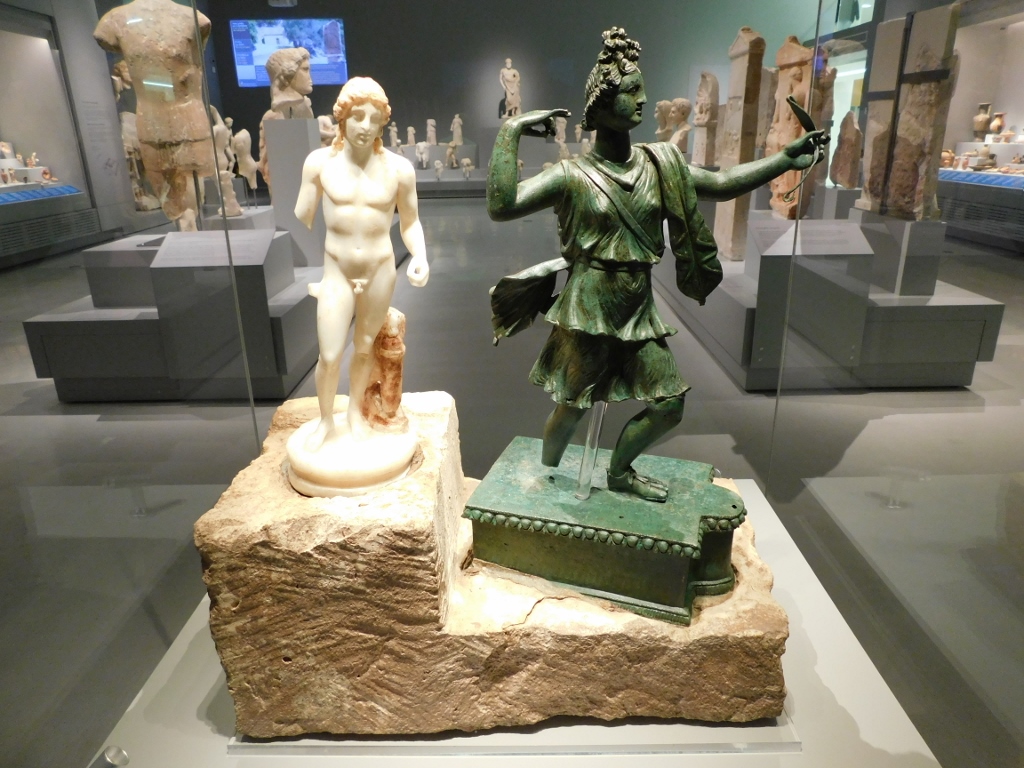 Archaeological Museum of Chania, Group of Artemis and Apollo
Archaeological Museum of Chania, Group of Artemis and Apollo
There are also several mosaics found in the houses from the Roman period (III century CE).
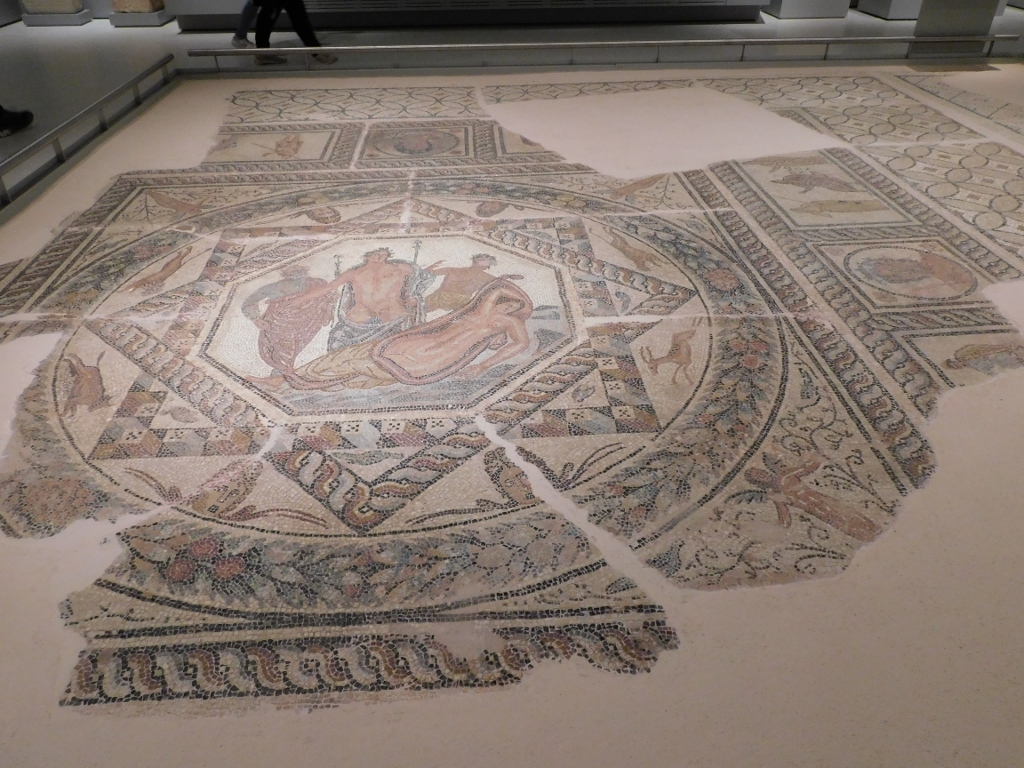 Mosaic from the “House of Dionysus”
Mosaic from the “House of Dionysus”
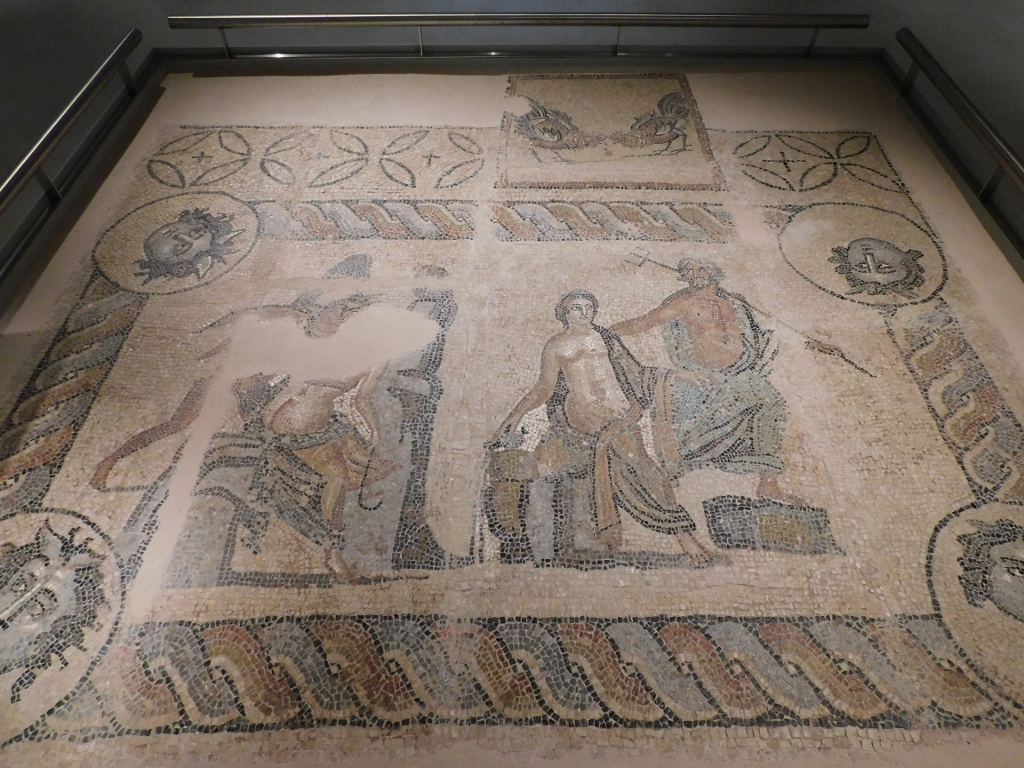 Mosaic from the “House of Poseidon and Amymone”
Mosaic from the “House of Poseidon and Amymone”
After I had finished with my visit to the museum, I took advantage of the fact that it had stopped raining, so now I walked a little around Chalepa, since there is a very interesting church near the museum.
Let me just say that a few hundred metres from the Archaeological Museum in Chalepa, there is also the museum Residence of Eleftherios Venizelos (1864-1936) and some 3 km further to the east is a cemetery where this famous Greek statesman and one of the leaders of the Greek national liberation movement is buried.
However, I was not interested in visiting these places since I had quite different plans, but this church I wanted to see was just a few minutes on foot away from the museum where my car was parked. This is the Church of St. Mary Magdalene.
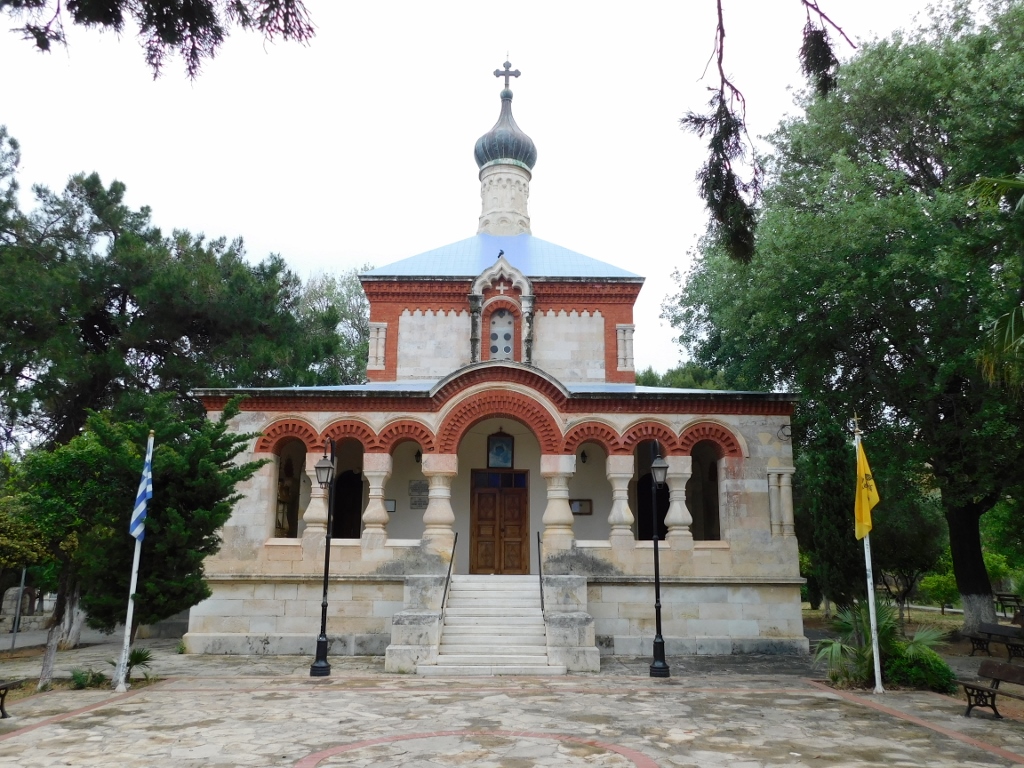 Church of St. Mary Magdalene
Church of St. Mary Magdalene
The churchyard is more like a small, well developed park and the church, as may be concluded from the photo above, was built in line with the Russian orthodox architecture. The construction of the church started in 1901 and it was officially dedicated to St. Mary Magdalene in 1903. The reason for building a Russian church right here was that opposite of it there was the residence of Prince George of Greece who in 1898 became the High Commissioner of Crete. His sister, Maria, was married to the Grand Duke George of Russia and when she came for an official visit to her brother on Crete, her husband gave a donation for the construction of the church. The consecration ceremony was attended by the mother of Prince George and his sister Maria, Queen Olga of Greece who was also Russian by birth (member of the Romanov dynasty).
At the time of my visit the church was closed, so I just made a circle around it and then I returned to the parking lot by the museum, got into the car and started with my visit to west Crete.
The first destination was the Cave of Saint Sofia in the Topolia Gorge, by a village of the same name. The cave is most often mentioned by its Greek name – the Cave of Agia Sofia.
To start with, I should say that although it is only 1.5 km long the Topolia Gorge is very picturesque and one can go for a walk there. As for the road, there are numerous curves and the owner of the agency where I rented a car told me to drive particularly carefully here since the road may be slippery on account of the rain. It also frequently happens that rocks fall from above. Well, I would not know how to avoid that one, but nothing of the sort happened, so it all went well, both for me and the car.
As for the cave, it can only be slightly discerned from the road.
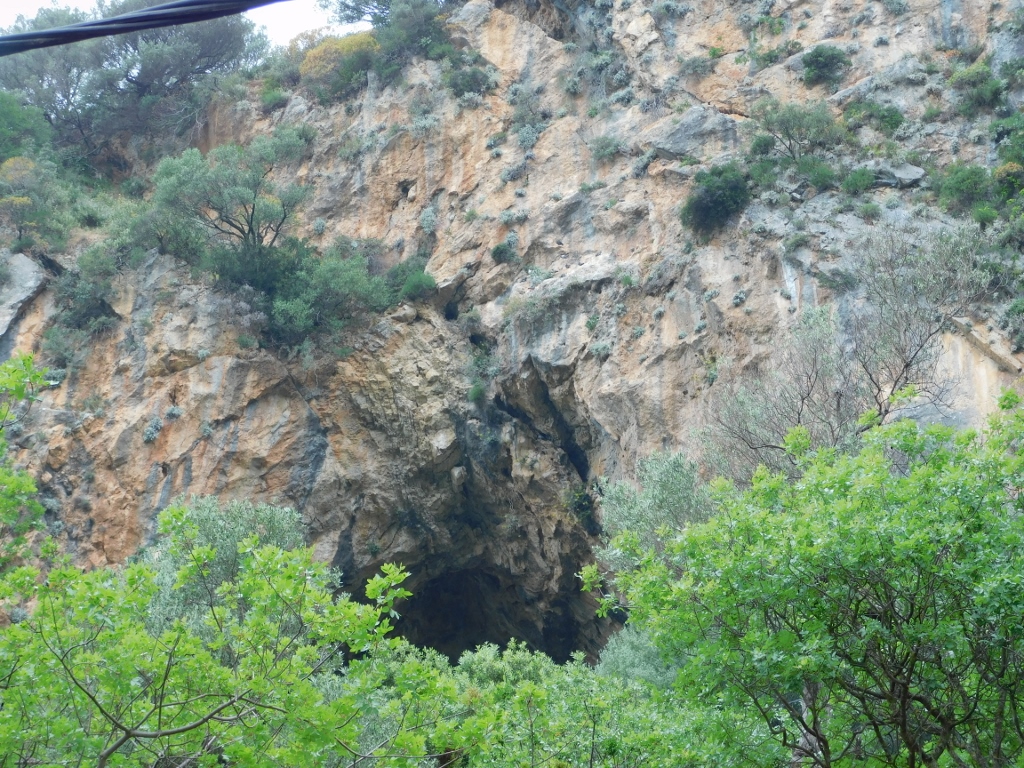 Cave of Agia Sofia
Cave of Agia Sofia
As I climbed up towards the cave, I noticed by the side the beautiful picturesque plant that I had come across in large numbers the previous day when I was in the Samaria Gorge. This was the dragon arum (Dracunculus vulgaris).
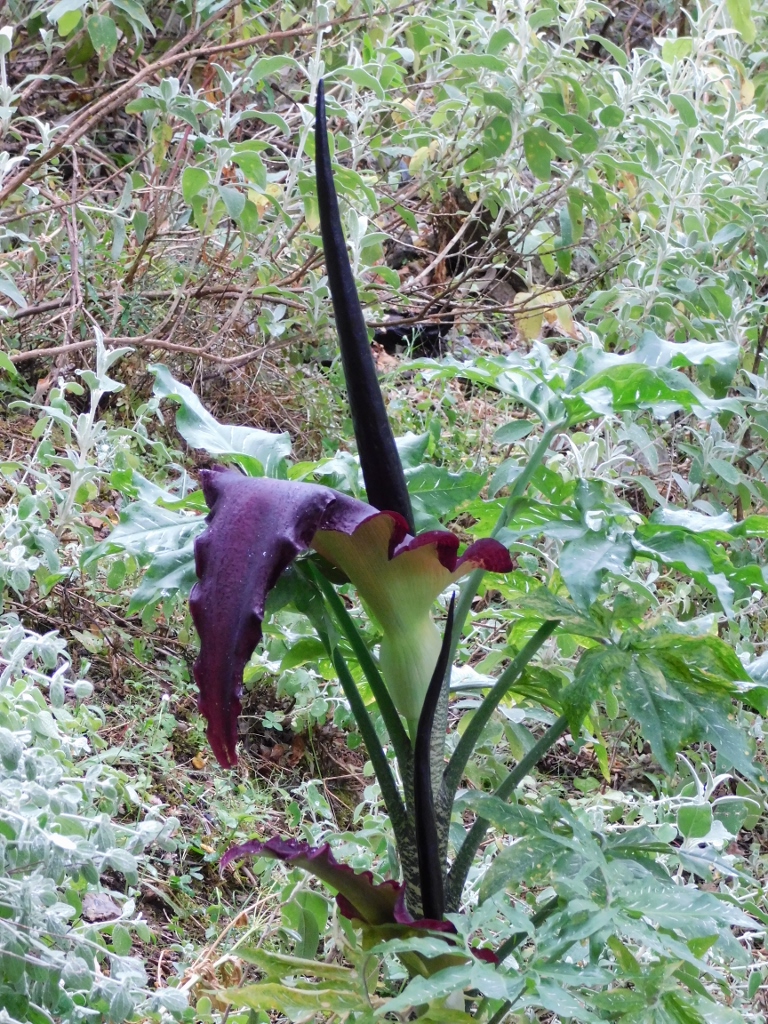 Dragon arum
Dragon arum
Soon I could see the bell-tower with a metal star on the top that stands at the entrance into the cave.
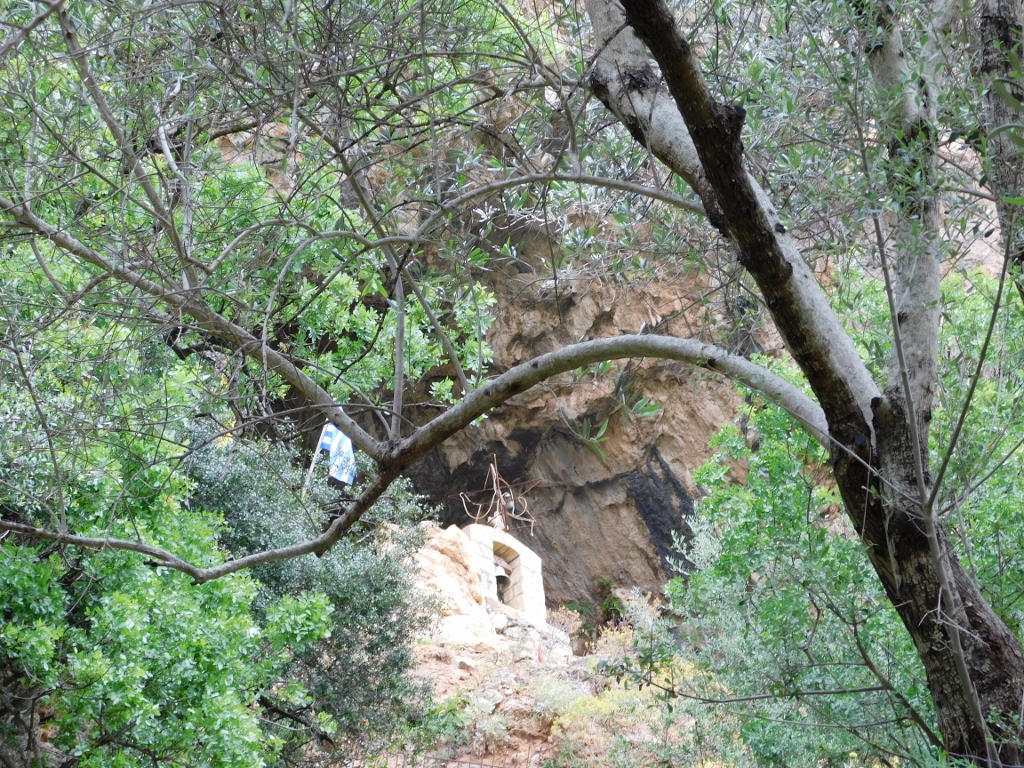 Cave of Agia Sofia
Cave of Agia Sofia
Only once you’ve climbed up to the cave can you realise that it is in fact quite big and it includes a dome that is 20 m tall, while its diameter is 70 m. There are also numerous stalactites and stalagmites some of which are 5-6 m tall.
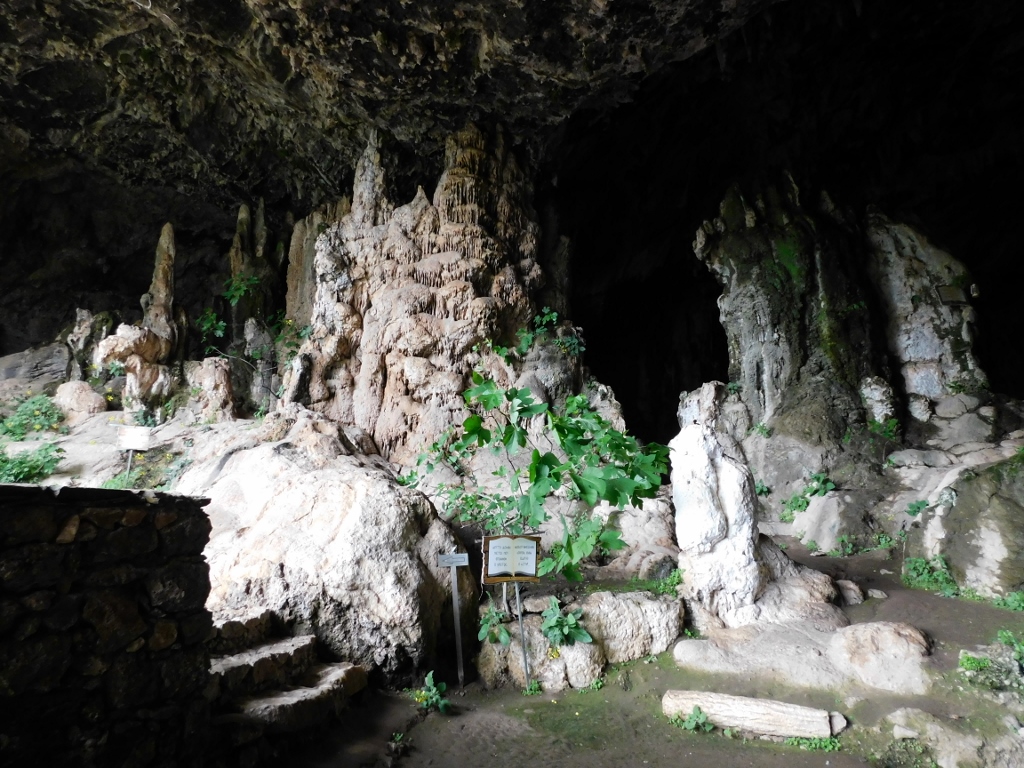 Cave of Agia Sofia
Cave of Agia Sofia
 Cave of Agia Sofia
Cave of Agia Sofia
In the photo above, on the left-hand side, you can notice a structure. This is a tiny Church of St. Sophia, which means that it is dedicated to the Holy Wisdom. It has been built adjacent to the cave wall, but at a slightly lower level, so it seems even smaller than it really is. It can be seen a little better in the following photo that also shows on the left-hand side the bell-tower with the cross on top. The metal star cannot be seen because of the too much light.
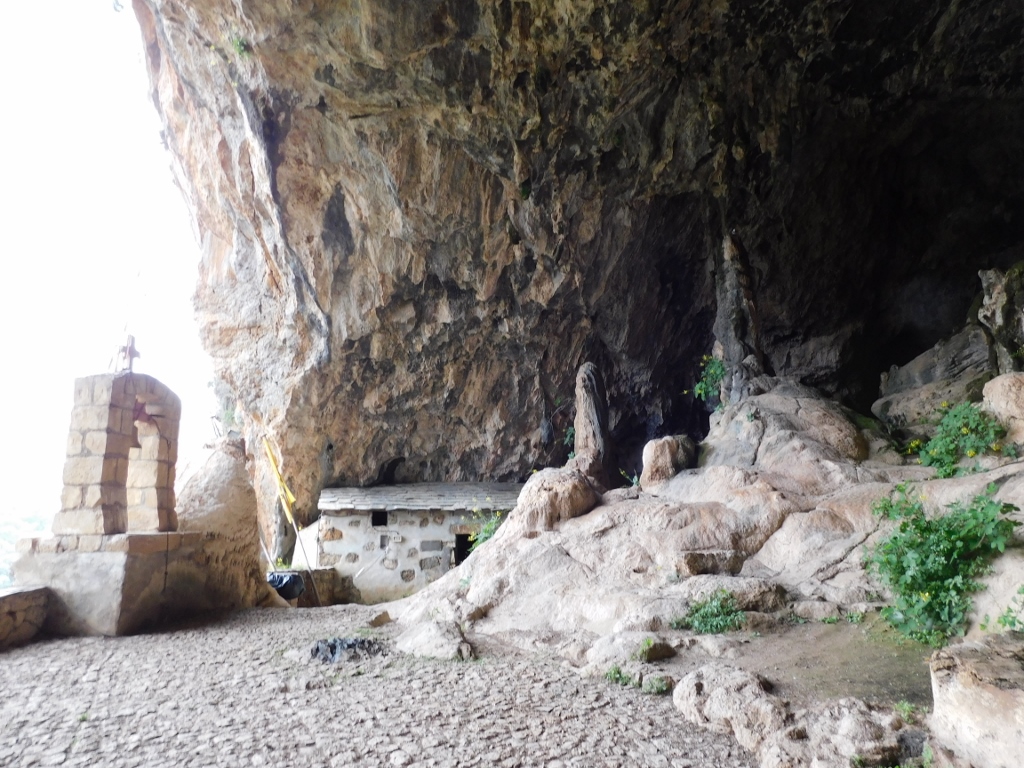 Cave of Agia Sofia
Cave of Agia Sofia
The interior of the church is very simple and in line with the surroundings.
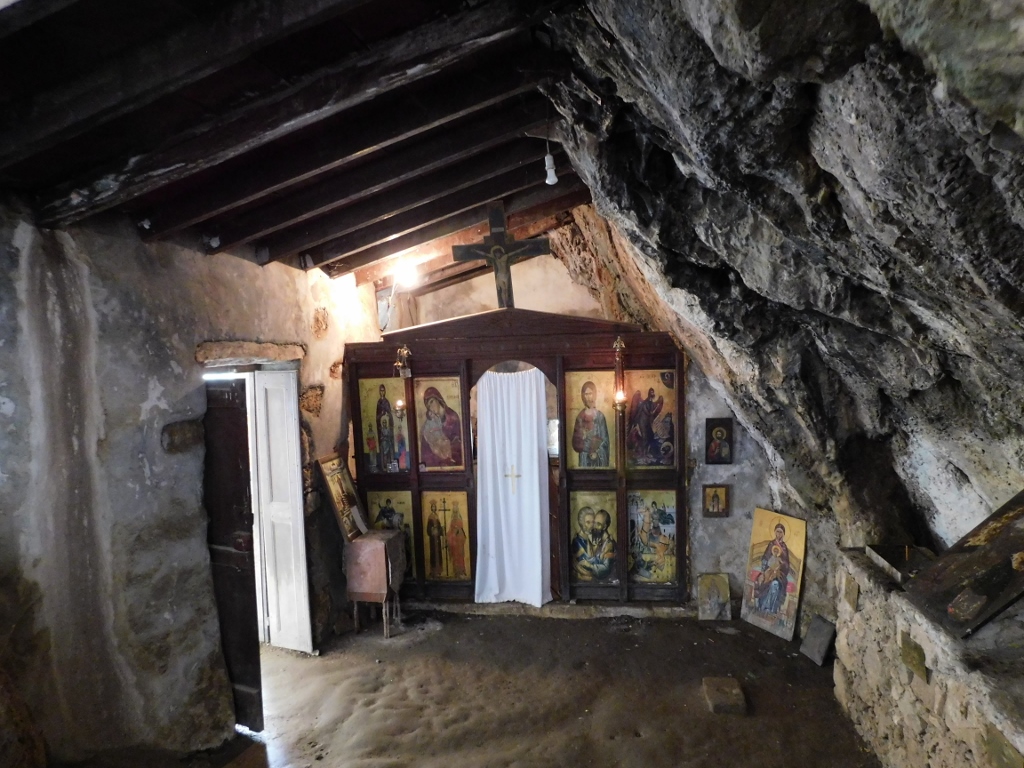 Cave of Agia Sofia
Cave of Agia Sofia
When I got out of the church, I climbed to the part with the stalagmites, where this is allowed, and from there I had a nice view at the wide entrance into the cave.
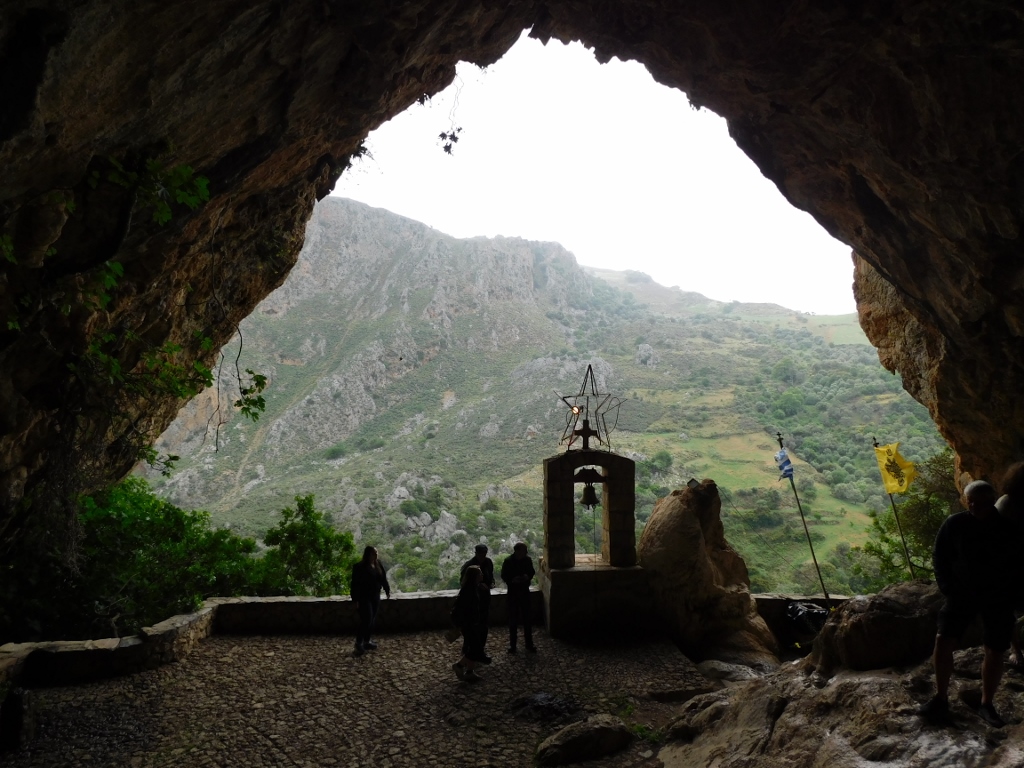 Cave of Agia Sofia
Cave of Agia Sofia
The cave has not been fully explored and it is believed that it is much longer than what is currently known about it, but this is up to the speleologists. As for the archaeologists, numerous objects from the past have been found in the cave over time, including also some shells from the Neolithic period. And as for me, I ventured into the cave just a little bit, but I was not too keen on going any further into the dark. I was much more impressed by the view at the central section.
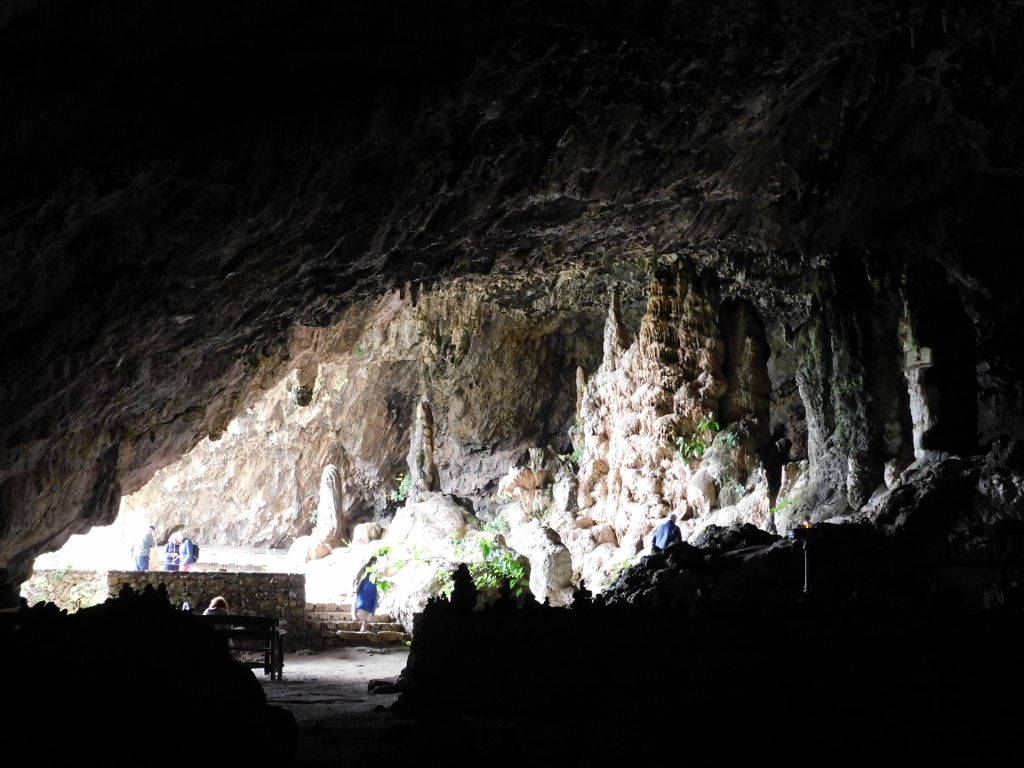 Cave of Agia Sofia
Cave of Agia Sofia
Soon I started to descend towards the road and the car, and along the way I walked underneath a lush fig tree once again.
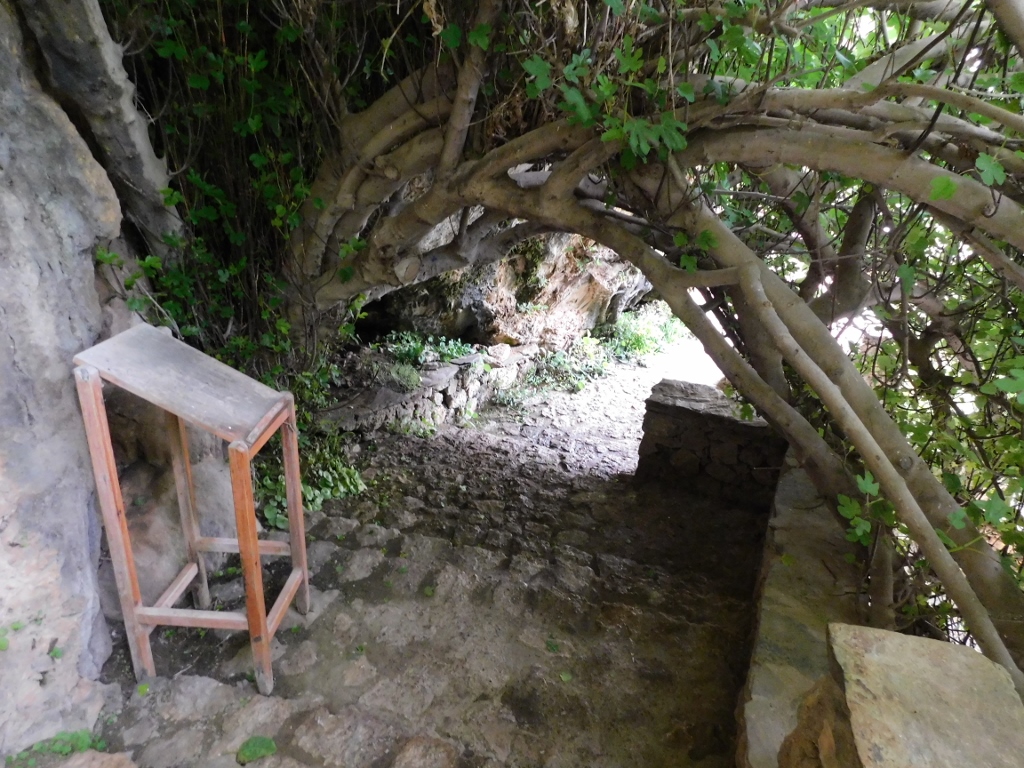 Fig tree above the path leading from the Cave of Agia Sofia
Fig tree above the path leading from the Cave of Agia Sofia
Before entering the car, I took a photo of the Topolia Gorge.
 Topolia Gorge
Topolia Gorge
The next destination on my excursion of the day was Chrysoskalitissa Monastery and when I first approached the west coast of Crete by road, the sky was almost completely with no clouds. However, an exceptionally strong wind prevented me from staying here longer and I just stopped very briefly in order to take photos of the sea.
 West coast of Crete
West coast of Crete
Soon I reached Chrysoskalitissa Monastery.
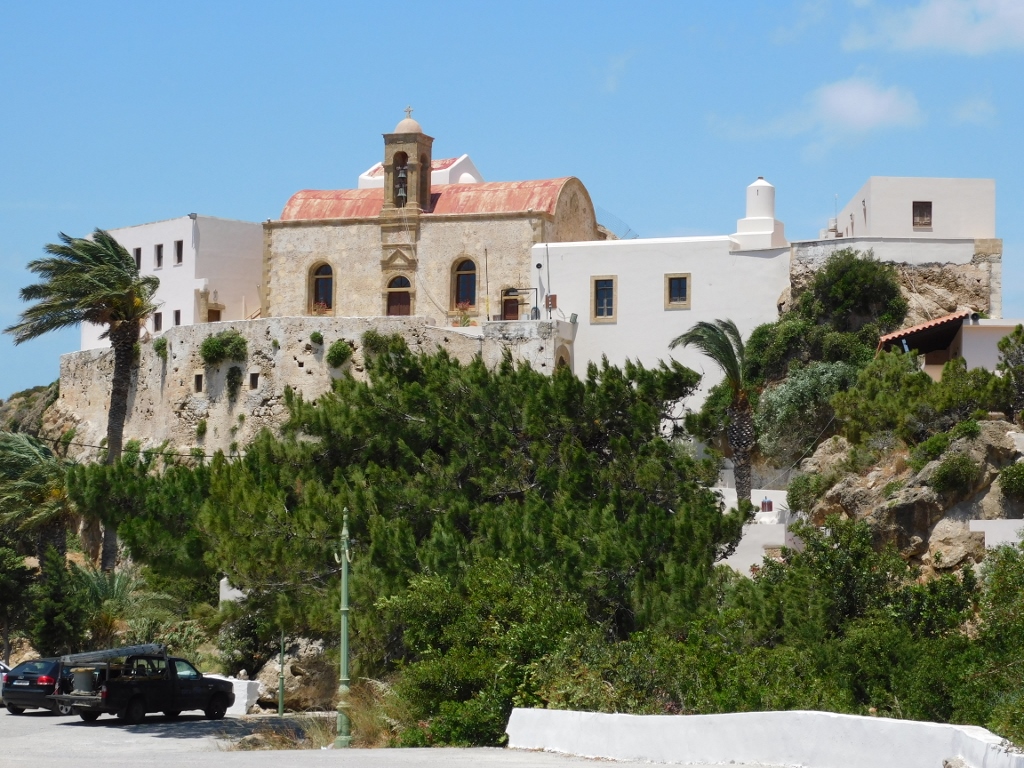 Chrysoskalitissa Monastery
Chrysoskalitissa Monastery
Although the exact date of its founding is unknown, the monastery built on a rock rising 35 m above the Libyan sea was first mentioned in the XVII century when Crete was still ruled by the Venetians. The name of the monastery more or less means “a gold step,” because according to a legend the last of the 98 steps leading up to the monastery is made of gold and only the true believers can see this. Let me say right away that I did not notice any gold step.
The monastery is dedicated to the Assumption of the Theotokos and also to the Holy Trinity. In 1894, the old, smaller church was demolished and a new, larger one was built in its place. The latter is still here today.
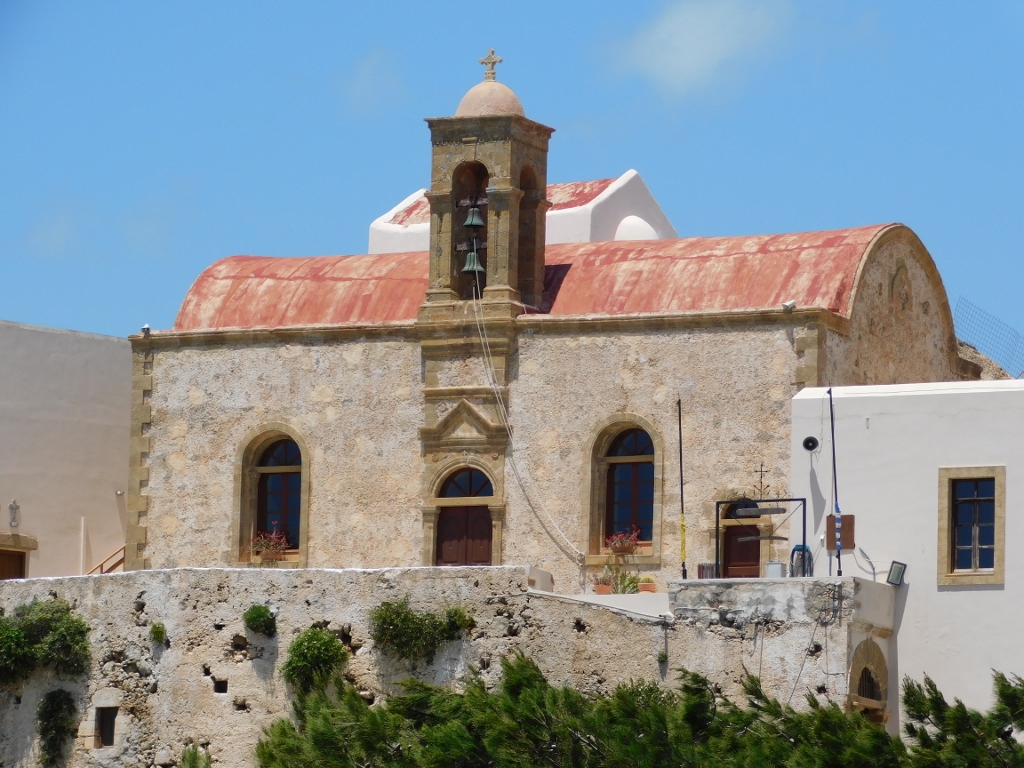 Chrysoskalitissa Monastery
Chrysoskalitissa Monastery
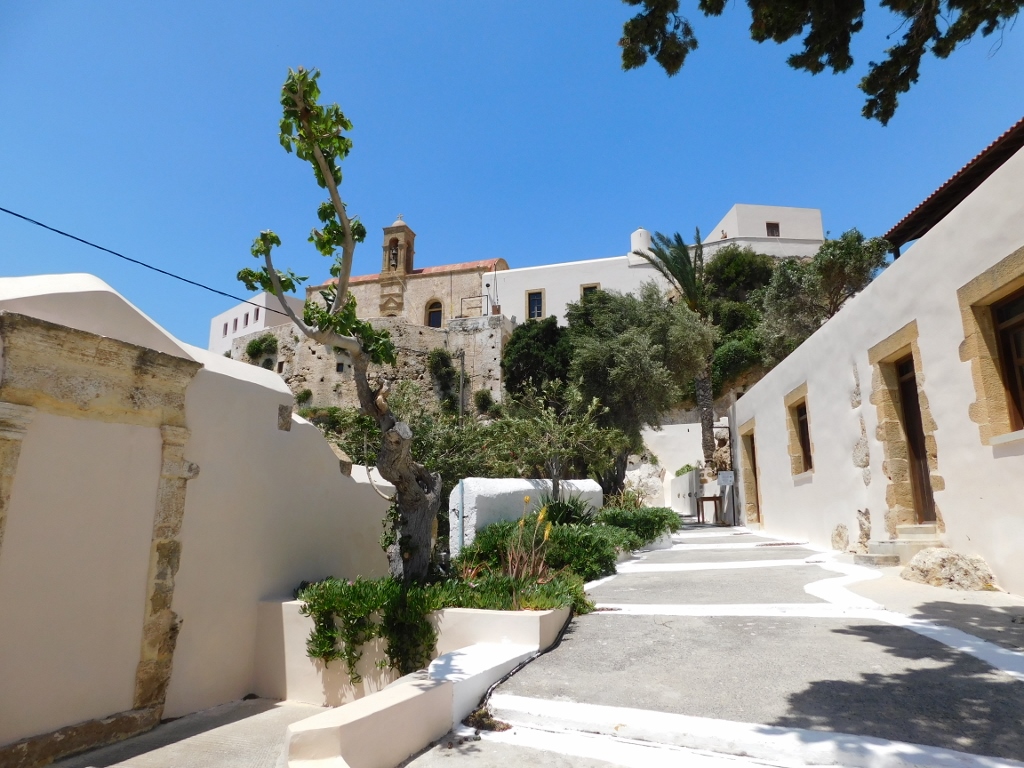 Chrysoskalitissa Monastery
Chrysoskalitissa Monastery
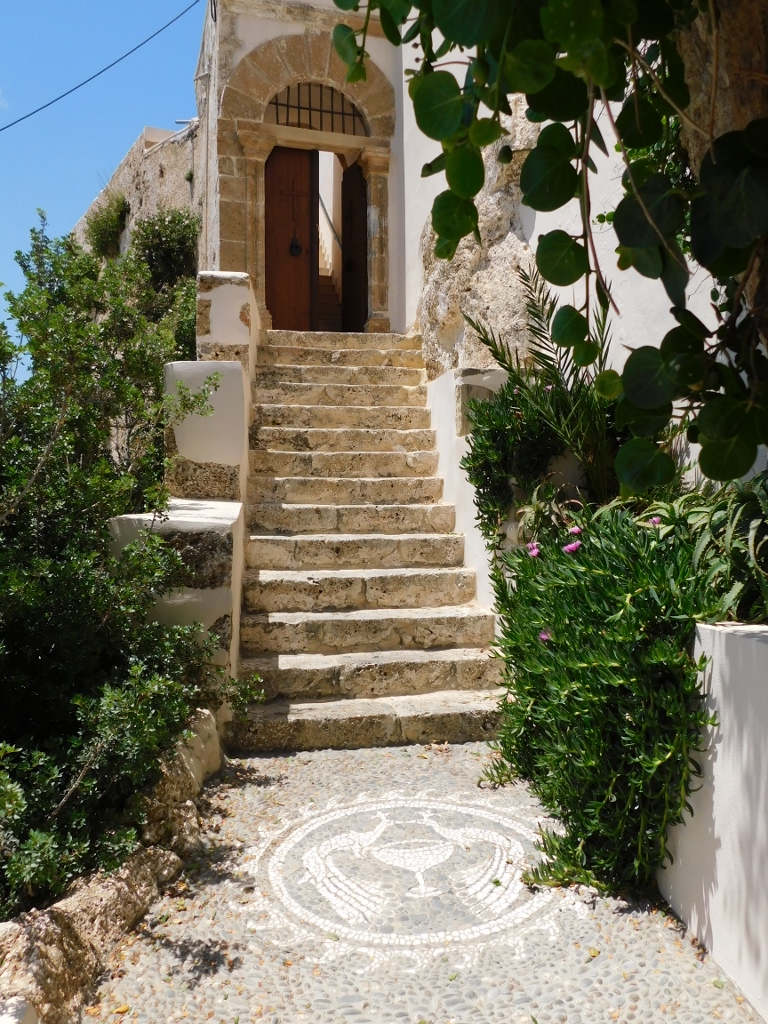 Chrysoskalitissa Monastery
Chrysoskalitissa Monastery
After I had climbed up to the church, I first paid attention to what could be seen from the plateau in front of the church. On one side there are different houses and a nearby village, while on the other there is a deep cove.
 Chrysoskalitissa Monastery, the surroundings
Chrysoskalitissa Monastery, the surroundings
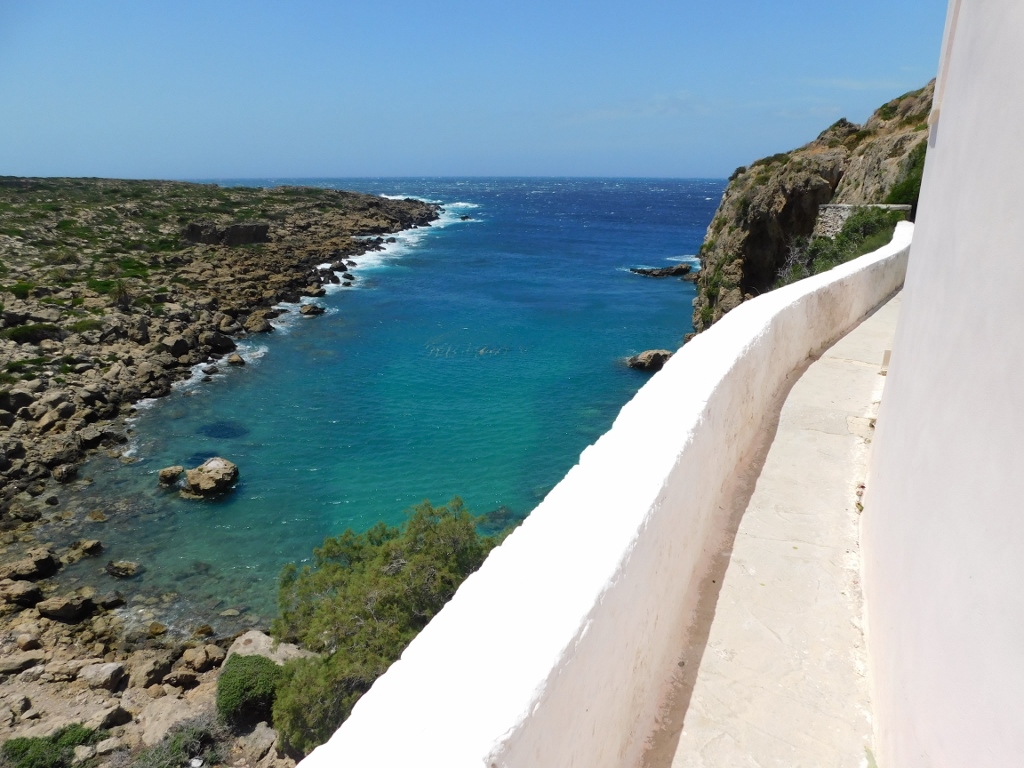 Chrysoskalitissa Monastery, the surroundings
Chrysoskalitissa Monastery, the surroundings
Then I concentrated on the church and also went in.
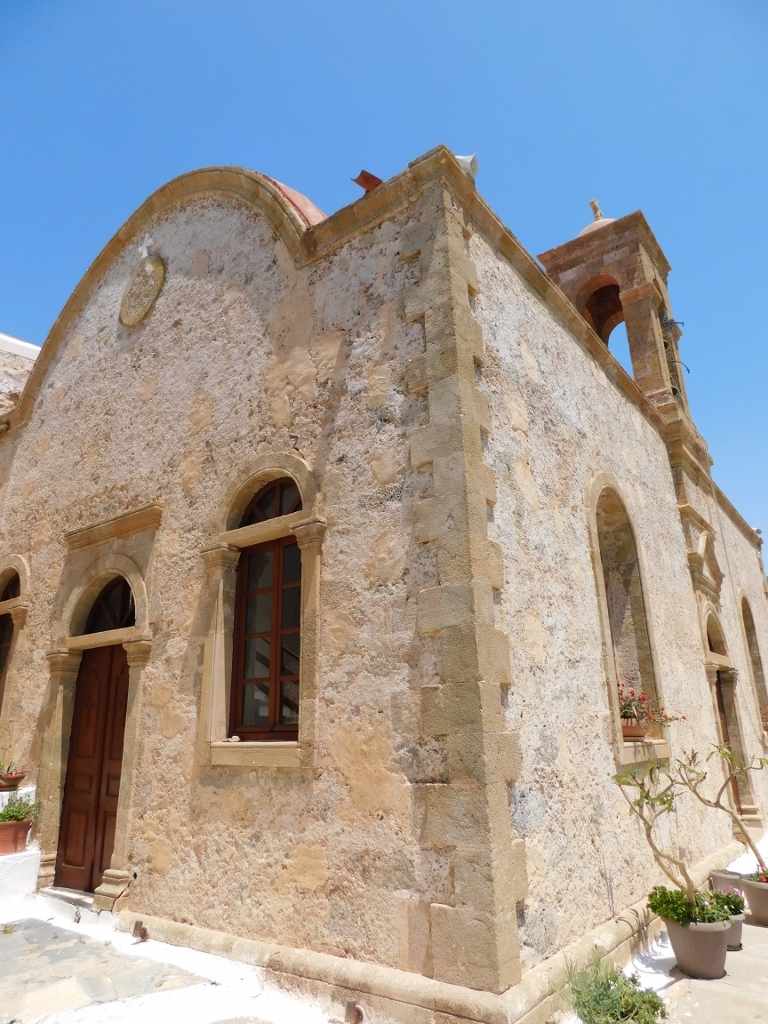 Chrysoskalitissa Monastery, the church
Chrysoskalitissa Monastery, the church
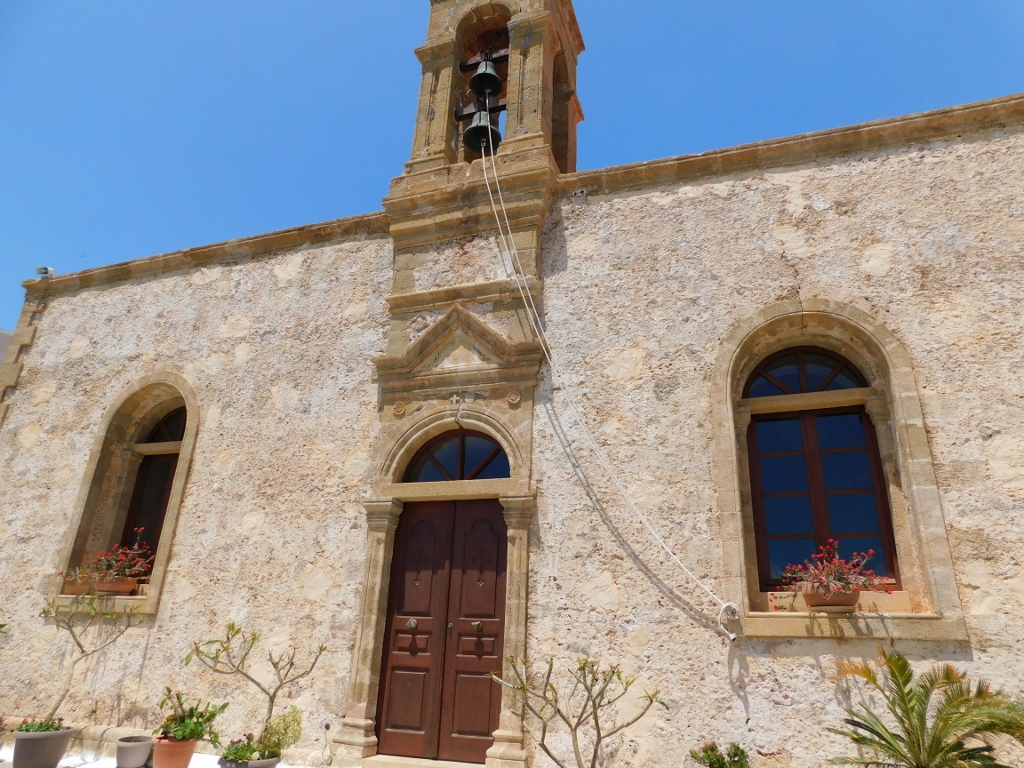 Chrysoskalitissa Monastery, the church
Chrysoskalitissa Monastery, the church
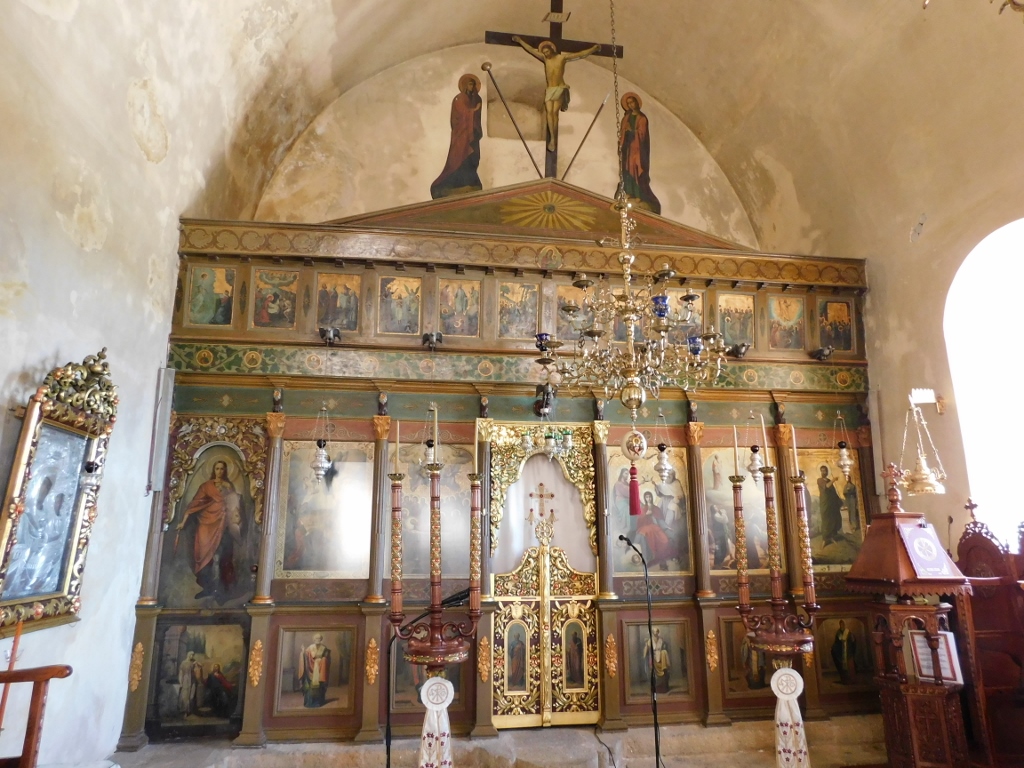 Chrysoskalitissa Monastery, the church interior
Chrysoskalitissa Monastery, the church interior
Within the monastery, there are also other buildings and some of them are intended for visitors, such as a couple of smaller museums. One dealt more with the ethnological aspects (the Folklore Museum), including also a room that used to serve as a secret classroom.
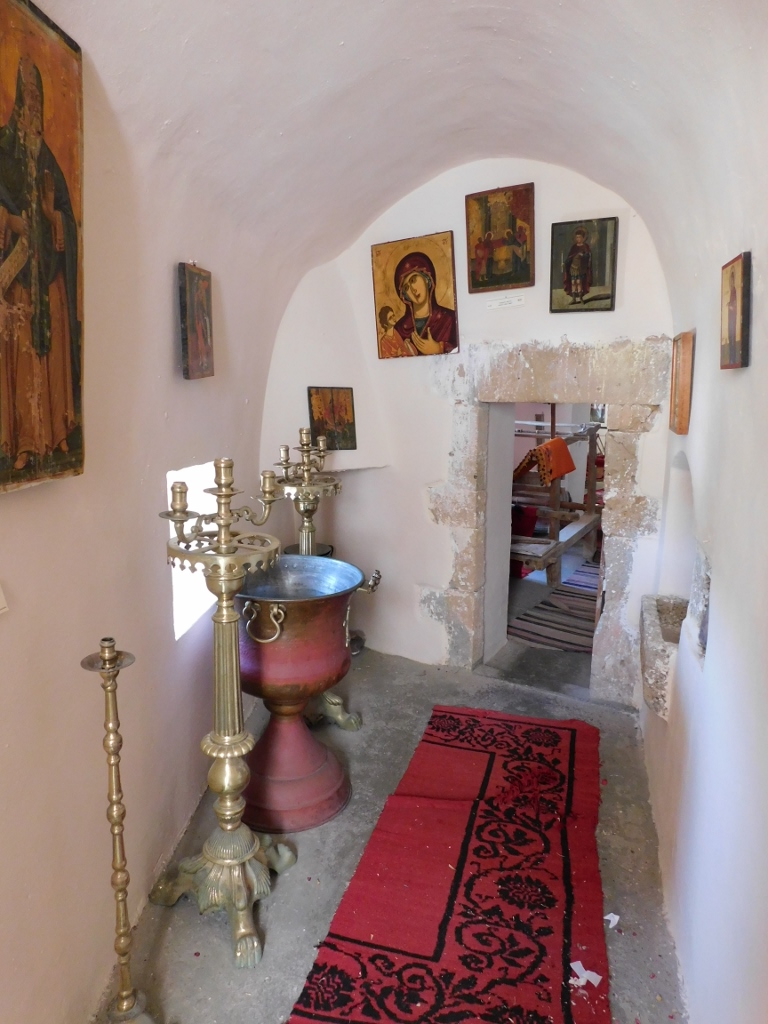 Chrysoskalitissa Monastery, a detail
Chrysoskalitissa Monastery, a detail
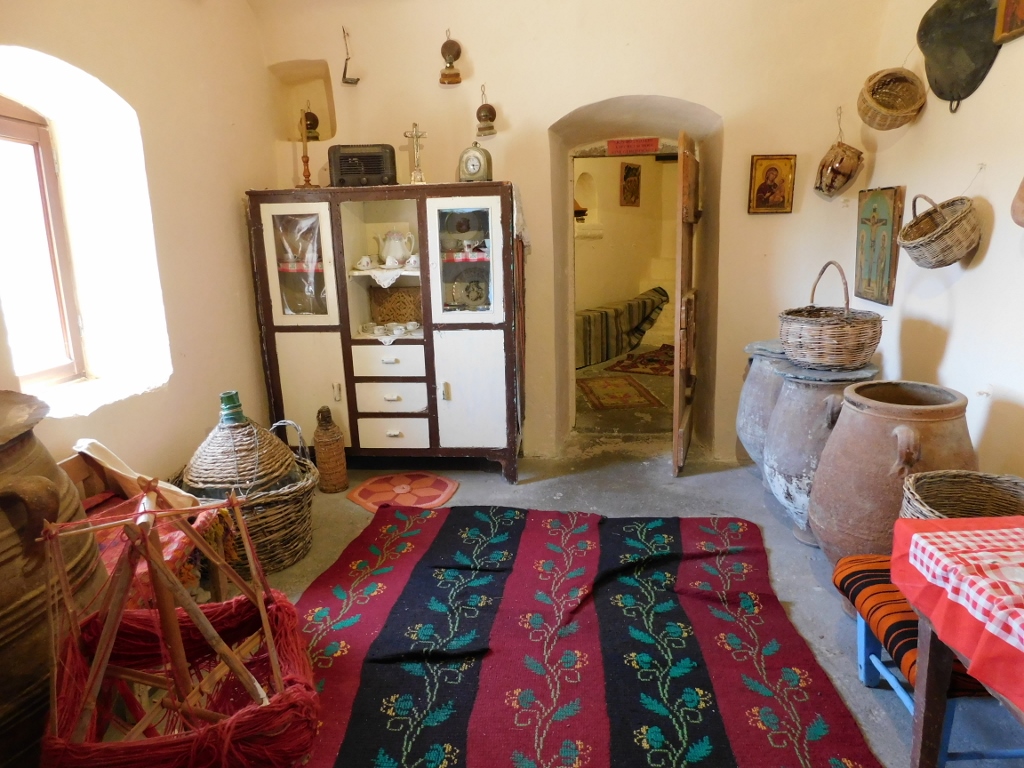 Chrysoskalitissa Monastery, a detail
Chrysoskalitissa Monastery, a detail
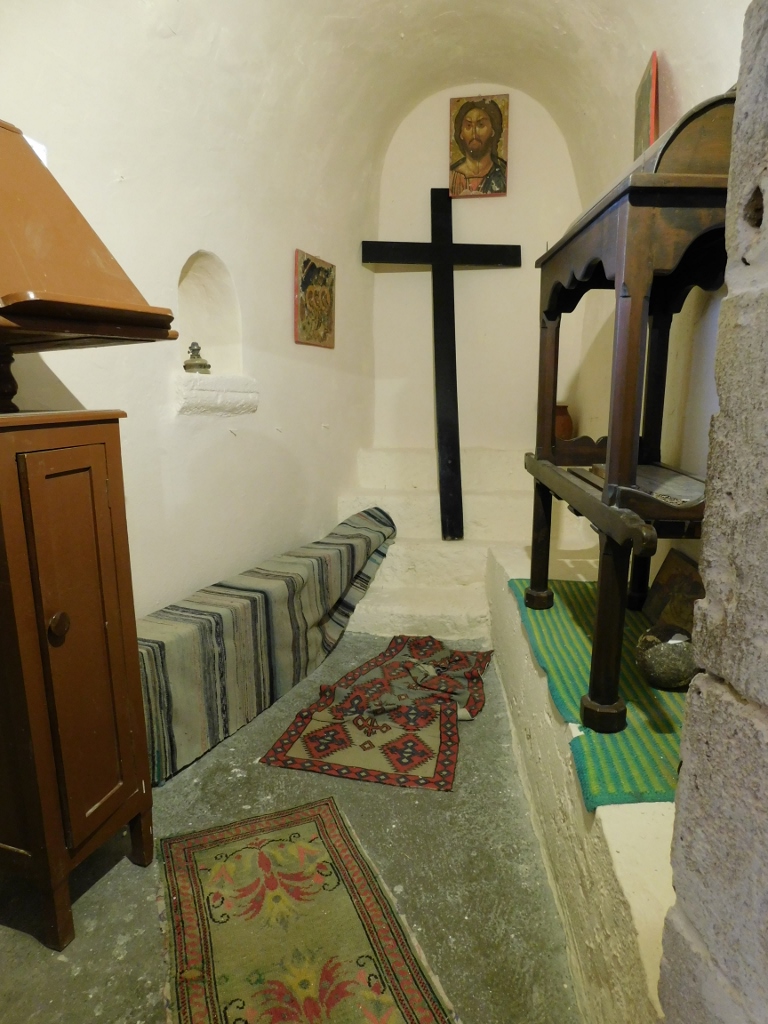 Chrysoskalitissa Monastery, a detail
Chrysoskalitissa Monastery, a detail
In the other, the Byzantine Museum, one can see different icons, as well as various objects used in liturgies.
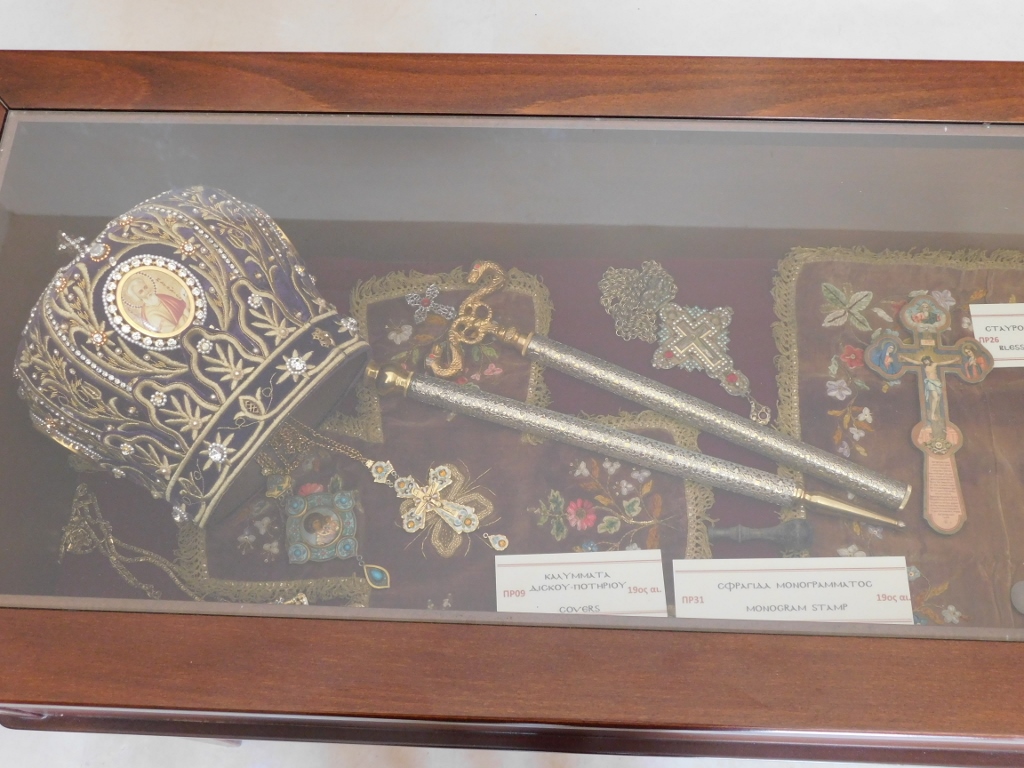 Chrysoskalitissa Monastery, a detail
Chrysoskalitissa Monastery, a detail
After the visit to the museums, I got into the car again and drove to the Elafonisi Beach. As I approached it, I briefly stopped in order to make a panorama photo of this place.
 Elafonisi Beach
Elafonisi Beach
Still, the main beauty of the place can fully be appreciated only once the visitor gets closer to the sea.
 Elafonisi Beach
Elafonisi Beach
There is a tiny, low islet that can be walked to. Depending on the tides, sometimes this is easier or less easy. When the tide is low, one needs to cover less than 20 m in order to walk from the sand beach on the shore to the sand beach on the islet. However, when I was here, I was supposed to walk a little bit more. Walking is never a problem in my case, but I had my photo and video equipment and I did not feel like venturing through the water. I enjoyed the beauty of the place from the shore.
 Elafonisi Beach
Elafonisi Beach
On both sides of this “interrupted bridge” made of sand there are shallow lagoons the bottom of which is covered in white sand and this creates some magical nuances of turquoise colour. In order for the “magic” to be even greater, you can clearly see that the waves roll to the shore some light pink sand. The effect is spectacular!
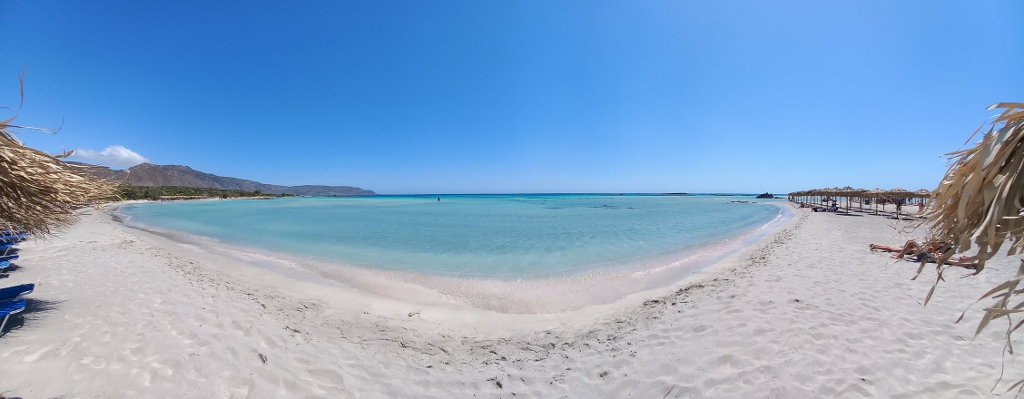 Elafonisi Beach
Elafonisi Beach
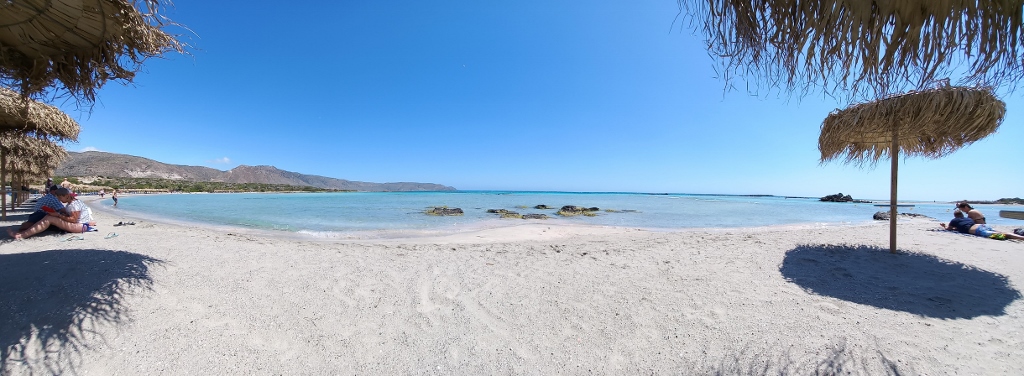 Elafonisi Beach
Elafonisi Beach
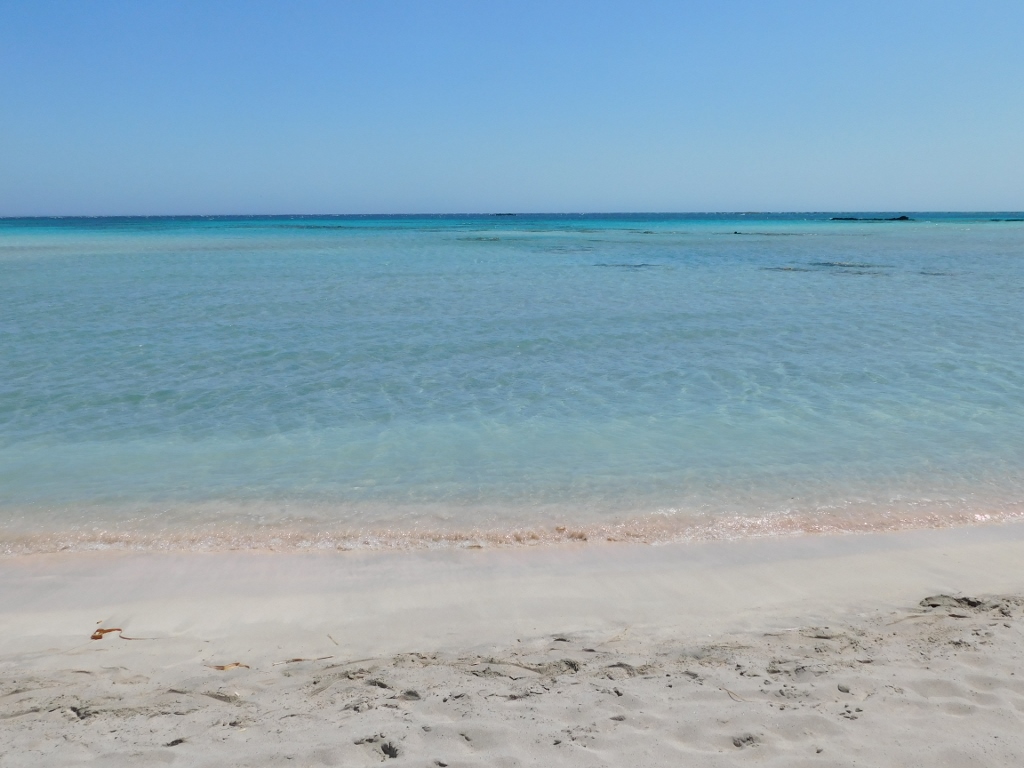 Elafonisi Beach
Elafonisi Beach
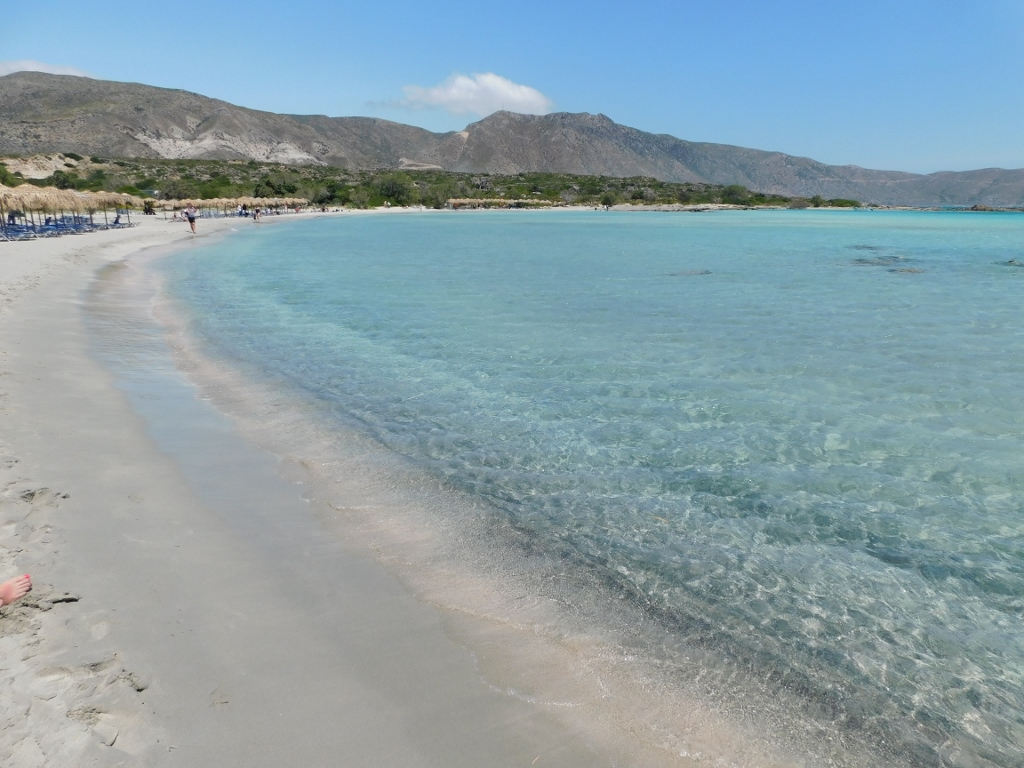 Elafonisi Beach
Elafonisi Beach
 Elafonisi Beach
Elafonisi Beach
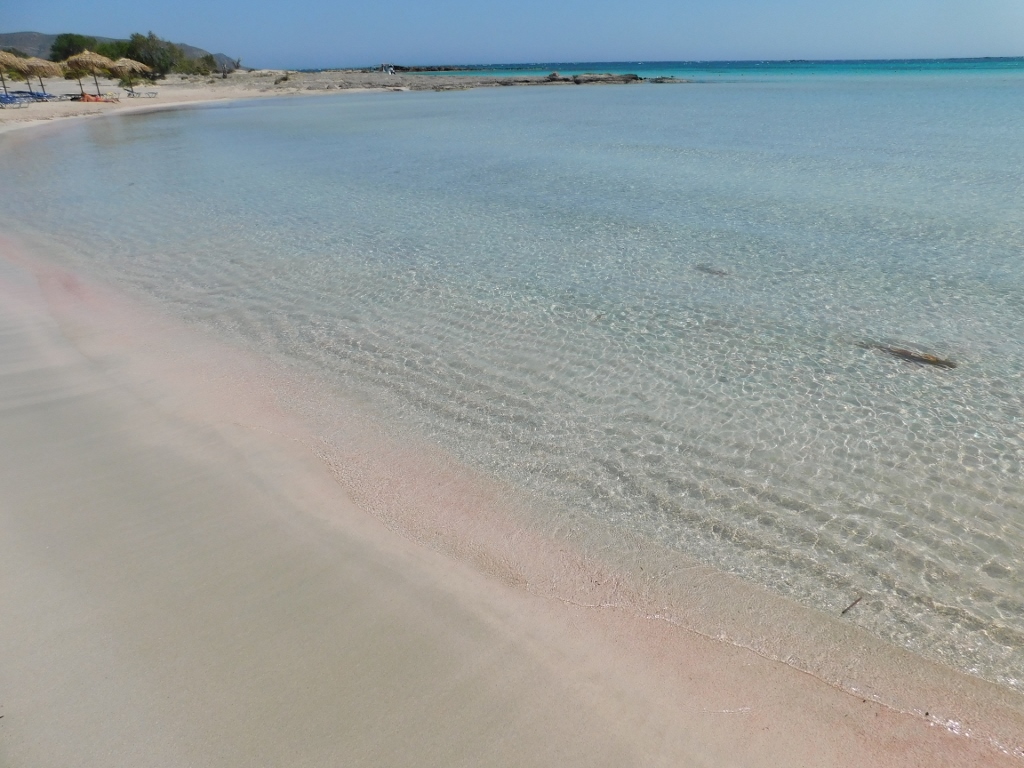 Elafonisi Beach
Elafonisi Beach
 Elafonisi Beach
Elafonisi Beach
I sat on the beach a little, then I walked and took photos for a short while, and when I felt like it was enough, I got back to the car and drove to a nearby restaurant where I sat at a table on the terrace in order to refresh a little, as well as enjoy the magnificent view.
 Elafonisi Beach
Elafonisi Beach
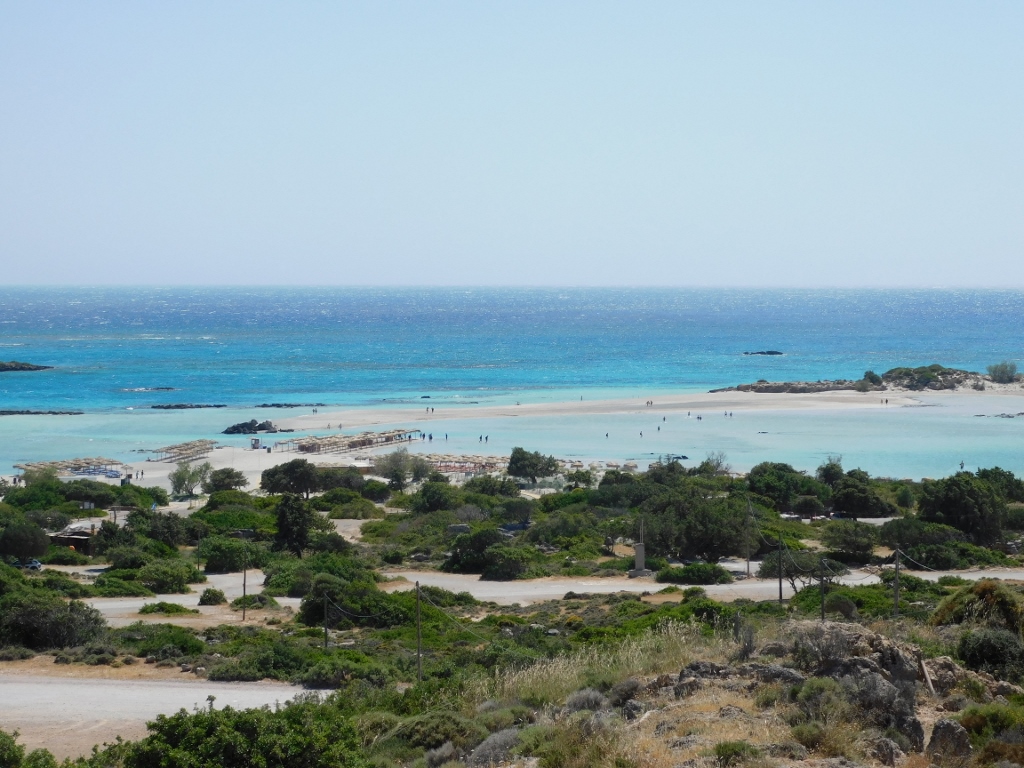 Elafonisi Beach
Elafonisi Beach
After this, I was ready to continue with my sightseeing of west Crete.